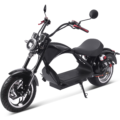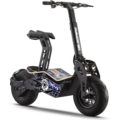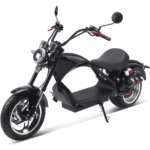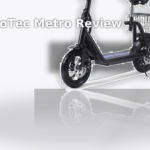- Home
- Scooters
- Electric Scooters
- MotoTec Switchblade
MotoTec Switchblade
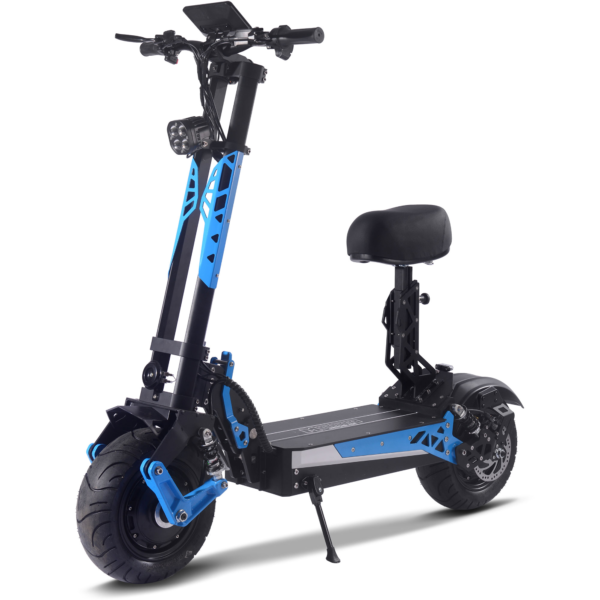

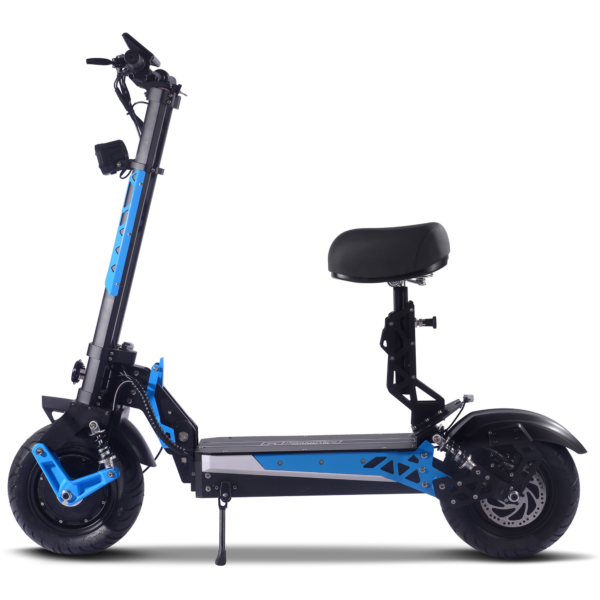

- Battery Range: 20–37 miles (32–60 km)
- Top Speed: 50 mph (80 km/h)
- Motor Power: 4000 W (dual hubs)
- Weight Capacity: 330 lb (150 kg)
- Charging Time: ~6–8 h
- Scooter Weight: 154.0 lb (69.9 kg)
PROS
- Dual 4000W hub motors; 50 mph top speed
- 60V 28Ah battery; 20–37 mi range
- Hydraulic disc brakes front & rear
- Dual suspension; 130/50-8 tires
- LCD with speed/odo/trip/battery
CONS
- Very heavy (154 lb)
- No IP rating listed
- No app connectivity
- Folded size not specified

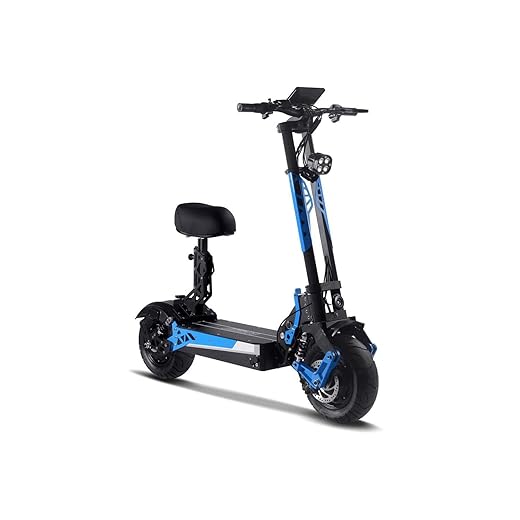
Key Takeaways
- The MotoTec Switchblade is a heavy-duty electric scooter designed for stability, long speed, and comfort on longer rides.
- It features a dual-hub-motor, 60-volt battery, hydraulic disc brakes, and a removable padded seat for versatility.
- Expect a top speed of 50 mph and a range of 20-37 miles per charge depending on conditions and rider weight.
- Its durable design includes an aluminum frame, wide tires, and suspension for smooth rides, while also incorporating safety features like full fenders and bright LED lights.
- The scooter suits riders needing a robust option for suburban or campus routes, but it may not be ideal for those requiring lighter, more portable solutions.
Table of contents
- What Is the MotoTec Switchblade?
- How the MotoTec Switchblade Works
- Key Specifications
- Design & Build Quality
- Performance Fundamentals
- Battery, Range & Efficiency
- Ride Quality & Comfort
- Braking & Safety Features
- Portability & Daily Usability
- Maintenance & Care
- Weather & Seasonal Considerations
- MotoTec Switchblade vs Alternatives
- Who the MotoTec Switchblade Is (and Isn’t) For
- FAQs
- Glossary
- Final Notes on Setup and Use
The MotoTec Switchblade is a heavy-duty sit-or-stand electric scooter built for power, stability, and long straight-line speed. It suits riders who want strong pull, real suspension, and a seat for longer trips. It is not a featherweight commuter, and it does not pretend to be one. So it clicks with riders who want a planted ride and long, steady runs. We’ll walk through the specifications in plain English, then share what it feels like on the road. If you’re eyeing a smaller city ride, the MotoTec Metro review is a helpful comparison.
What Is the MotoTec Switchblade?
The MotoTec Switchblade is a dual-hub-motor scooter with a 60-volt lithium-ion pack and hydraulic disc brakes. It ships with a padded seat you can remove, and the frame folds to help with transport and storage. The cockpit uses an LCD for speed, trip, odometer, and battery readouts. And bright LED lighting and full fenders come standard. Then the design adds wide tires and real suspension, so the scooter holds its line on imperfect pavement.
How the MotoTec Switchblade Works
An electric scooter is simple at heart. You turn the key, twist the throttle, and current moves from the battery to the motor controllers. Those controllers meter power to the hub motors, which sit in the wheel hubs and spin the wheels directly. That removes chains and belts, so there are fewer moving parts to fuss over.
On the Switchblade, you use a twist-grip throttle on the right. The LCD next to it shows speed and trip data, so you can hold a steady pace. You squeeze hydraulic brake levers to clamp calipers onto the rotors. Fluid pressure gives firm, even bite, so stops feel predictable. Next, the front and rear shocks soak up cracks and ruts, so the chassis tracks straight instead of skipping.
The 60-volt, 28-amp-hour battery stores energy in watt-hours: 60 × 28 = 1,680 Wh. That is a big tank for a scooter. And it includes an Economy button that trims draw when you want longer range. Then you plug into the charger and wait for the pack to reach full voltage. The LCD’s battery bar helps you plan the next ride, and the trip meter confirms how far you went.
Key Specifications
These are the benchmark numbers for setup and planning.
General
| Item | Detail |
|---|---|
| Model | MotoTec Switchblade |
| Form factor | Foldable frame with removable seat |
| Age guidance | 13+ years |
| Max rider weight | 330 lb (150 kg) |
Performance & Power
| Item | Detail |
|---|---|
| Drive | Dual brushless hub motors (listed output 4,000 W total) |
| Rated top speed | 50 mph (80 km/h) |
| Riding modes | Economy button for reduced draw |
Battery, Charging & Electrical
| Item | Detail |
|---|---|
| Battery | 60 V / 28 Ah lithium-ion (≈ 1,680 Wh) |
| Charge time | 6–8 hours |
| Display | LCD: speed, trip, odometer, battery, light indicator |
| Lighting | Front and rear LEDs |
Build & Dimensions
| Item | Detail |
|---|---|
| Frame & deck | Aluminum alloy |
| Tires | 130/50-8 street tires (8-inch rim) |
| Suspension | Dual front shocks, dual rear shocks |
| Wheelbase | 43.3 in (110 cm) |
| Min. ground clearance | 7 in (17.8 cm) |
| Seat height | 32 in (81 cm) |
| Unfolded size | 57 × 25 × 51 in (145 × 63.5 × 130 cm) |
| Folded size | Not published |
| Scooter weight | 154 lb (70 kg) |
| Box size/weight | 59 × 15 × 26 in (150 × 38 × 66 cm) / 168 lb (76 kg) |
Safety & Control
| Item | Detail |
|---|---|
| Brakes | Front and rear hydraulic disc |
| Fenders | Front and rear full fenders |
| Throttle | Twist-grip |
Features & Extras
| Item | Detail |
|---|---|
| Seat | Padded seat included, removable |
| Economy mode | Yes |
| Folding | Yes |
Warranty & Compliance
| Item | Detail |
|---|---|
| Warranty | 60-day parts replacement (manufacturer) |
| IP rating | Not published |
| Local laws | Vary by region; check rules before riding |
Design & Build Quality
The Switchblade looks and feels like a road scooter first. The chassis uses aluminum alloy for the frame and deck, so it holds shape under load. And the welds and hardware sit clear of foot space. The deck is long enough to place your front foot forward and your rear foot across. The stem feels sturdy, and the folding latch locks with a clear snap. Then the fenders keep spray down on wet pavement.
You sit higher than on many seated scooters. The listed seat height is about 32 inches, so leg angle stays open and relaxed. The padding is firm enough for long rides. You can remove the seat if you want a more athletic stance. The cockpit is simple: throttle, two levers, switches for lights and mode, and an LCD you can read at a glance. The cables route cleanly to the bars, and the headlight sits high for better throw.
The wheels use wide 130/50-8 tires. They plant a broad contact patch and help the scooter track straight at speed. Next, the dual-shock setup front and rear keeps the wheels on the ground while the chassis stays calm. You will still feel deep potholes, yet the scooter resists harsh kickback. And the hydraulic brakes round out the package. Lever travel is short and firm, so you can modulate with two fingers.
Performance Fundamentals
Power delivery matters more than peak numbers. The Switchblade’s dual hubs come on strong from a stop, and they keep pulling through mid-speed. So starts feel assertive, and gaps in traffic shrink. Then the motors ease off near the top of the speed range. On rolling city streets, you spend more time in the mid-band, and the scooter stays smooth there.
Hill work tests any scooter. On grades around 7–10%, the Switchblade holds speed better than light commuters. It does not leap up very steep hills, yet it refuses to bog or stall. So you crest with less drama, and you do not need to kick. Headwinds take a bite on open roads, and the 60-volt system helps keep current draw reasonable. Then heat stays in check on normal runs.
Stability at speed depends on wheelbase, tire width, and stem stiffness. The wheelbase is about 110 cm, and the tires are broad, so straight-line tracking is strong. The shocks help the front wheel stay planted over ripples. On fresh asphalt, the ride is calm. On patched lanes, the front can chatter a bit. Even so, it settles quickly if you keep a light grip and let the suspension work.
Battery, Range & Efficiency
The 60 V, 28 Ah pack stores roughly 1.68 kWh. That is your fuel. Range shifts with rider mass, speed, climbs, surface, and temperature. The usual claim sits at 20–37 miles per charge, which converts to about 32–60 km. Use the low end if you weigh above 200 lb and cruise fast. Use the high end if you weigh less, ride in Economy mode, and hold 20–25 mph on level pavement.
So how do you stretch range on this scooter?
- First, keep speeds steady. Drag rises fast with speed.
- Next, set tire pressure in the middle of the recommended band so rolling resistance stays in check.
- Then use the seat on longer rides. A calm posture helps you hold a steady throttle.
- After that, charge soon after rides and avoid storing at 100% for long periods.
- Finally, favor short top-ups over deep empty-to-full cycles when you can.
Charging from near empty to full takes about 6–8 hours on the standard unit. If you ride daily, pick a simple habit: plug in when you get home, then unplug in the morning. And keep the charger off the floor in a dry, ventilated place. For example, a wall shelf with airflow keeps dust off the vents and cables out of the way.
Ride Quality & Comfort
Comfort starts with stance and contact points. The deck gives room to square your feet or stagger them. The grips feel firm and do not twist under load. The seat spreads pressure and keeps you fresh on long stretches. And the shocks take the edge off sharp hits, so your hands do not tingle after rough miles.
Tire type matters. These street-pattern 130/50-8s give a stable footprint and resist pinch flats. At the right pressure, they roll quietly and keep the scooter from tramlining on paint and seams. On cold mornings, they feel a bit stiff for the first mile. Then they warm up and grip better. In summer heat, watch pressure rise a few PSI as the day goes on. So check them midweek and before weekend rides.
Stem flex ruins confidence on tall scooters. Here, the stem feels stout for the class. Keep fasteners torqued and the latch clean, and play stays low. So the bars feel connected, and steering inputs land without lag. On broken concrete, bend your elbows and let the shocks do their job. For example, soften your hands over expansion joints, then reset your stance after the hit.
Braking & Safety Features
The Switchblade uses hydraulic discs at both ends, which raises confidence on long downhills. The first half of lever travel gives light scrub, then the pads bite harder. You can stop with two fingers on each lever, and modulation stays smooth near lockup. On wet roads, start braking a touch earlier and let the tires load up before you squeeze harder. Then ease off as you roll to a stop.
The lighting package includes a forward LED and rear lighting. The beam sits high enough for city use, and the rear helps drivers judge distance. Add reflectors or high-viz ankle straps if you ride near traffic at dusk. And make a habit of testing the brake lights before night rides. In short, light your path and make your motion clear to others.
The chassis ships with full fenders. So spray and grit stay off the deck and your back. That keeps the deck grippy, which matters when you stand. The LCD with speed and battery data helps you plan stops. And the Economy button trims draw when you need to finish a trip on the pack you have.
Portability & Daily Usability
Let’s be straight: this is a 154-pound scooter. That is about 70 kg. So you will not carry it up long flights of stairs. You will roll it to elevators, store it in a garage, and load it with a ramp if you need to. The folding latch helps with trunk loading, yet the weight means you should plan a stable lift and clear space on the floor. Then you can lower it in one smooth motion without straining.
The unfolded footprint is about 57 × 25 × 51 inches. That is 145 × 63.5 × 130 cm. The wheelbase gives stable tracking, and the deck height and ground clearance keep the underbody safe from speed humps. The seat height is about 32 inches, which suits most adult riders. And the folding step helps you stash the scooter lengthwise in a van or wagon. Folded dimensions are not published, so measure your space and test fit first if storage is tight. Next, mark the parking spot with tape to keep a clear path around the scooter.
For daily habits, store the scooter indoors and out of direct sun. Keep a floor mat under the parking spot to catch grit and to mark a safe “no trip” zone. Use two locks if you must leave it in a shared garage: one through the frame and one through a wheel. Then add a simple cover to hide the profile and keep dust off.
Maintenance & Care
A simple routine keeps heavy scooters smooth and safe. Use this schedule as a starting point.
Before each ride
- First, check tire pressure with a gauge. Spin the wheels to spot cuts or embedded debris.
- Then squeeze the levers to confirm a firm bite and smooth return.
- Next, rock the bars fore-aft to feel for stem play. Tighten the latch if needed.
- Finally, glance at the LCD battery bar and plan your distance.
Weekly
- Clean rotor faces with isopropyl alcohol if pads squeal.
- Check axle nuts and main fasteners. Add a drop of medium threadlocker where the manual calls for it.
- Wipe dust from the shock shafts so seals stay clean. Then cycle the suspension by hand to feel for smooth travel.
Monthly
- Check pad thickness and lever feel. Bleed the brakes if the lever feels spongy.
- Inspect cables and harness runs for pinch points near the hinge.
- Update your ride log: miles, average speed, and any new noises. For example, note a faint rattle and the fix you used.
Every 6 months
- True the rotors if you feel pulse under light braking.
- Inspect the folding latch pins and bushings for wear.
- Test the charger on a wall-meter for expected current draw. Then label the charger if you park in a shared space.
Treat the battery kindly. Avoid long storage at full or empty. Park it at about 40–70% if you will not ride for a week. Keep the pack dry. If the scooter gets soaked, dry the ports and leave it at room temperature before charging. Then resume normal use after it is fully dry.
Weather & Seasonal Considerations
Rain changes grip and vision. Slow down, lengthen stopping distances, and avoid paint and metal plates. The wide tires track well on clean wet asphalt, yet they can slide on leaves and diesel drips. After rain, test the brakes at low speed to clear water from the rotors. Then pick smoother lines to avoid puddles that hide potholes.
Heat shortens range. Batteries dislike high temps, so park in the shade and crack a garage door to vent hot air. Cold cuts range too. On winter mornings, your first mile may feel sluggish as the pack warms up. Plan 10–20% less range on days below 40°F (4°C), and ride smoother to compensate. Next, check pressure more often in winter, since cold mornings drop PSI.
If you live near the coast or ride salted roads, rinse the chassis with a light spray and dry it after each wet ride. Corrosion starts where water sits. So keep drains clear and store the scooter dry. Then wipe exposed hardware with a light protectant to slow surface rust.
MotoTec Switchblade vs Alternatives
Within big scooters, you see three broad types.
Commuter class: lighter frames, single motors, and lower top speeds. They shine on short urban hops and easy storage. The Switchblade beats them on hill hold, seat comfort, and braking power. But they win on weight and stair work.
Performance class: high-voltage packs, dual motors, and hydraulic brakes. The Switchblade belongs here. It stands out with a seat included from the factory, a broad deck, and a stable wheelbase. Some rivals sprint harder at the top, yet many ship without a seat or use skinnier tires. So the Switchblade favors long pavement runs with steady throttle. For pure city duty, the MotoTec Metro keeps weight and footprint down.
Off-road class: long travel suspension, knobby tires, and taller stances. The Switchblade is happier on clean or mixed pavement. It can handle rough patches and dirt connectors, and the shocks help, but its street tires do their best work on tarmac. For example, it feels better on bike lanes and frontage roads than on deep gravel.
So the Switchblade excels when your route mixes city arteries, suburban boulevards, and rolling back roads. It is less ideal for fifth-floor walk-ups or trains with strict size rules. Then again, owners with ground-floor storage will see the strengths daily.
Who the MotoTec Switchblade Is (and Isn’t) For
Great for
- Riders who want a seated option for long rides and steady cruising.
- Heavy riders who need a real 330 lb (150 kg) capacity.
- Suburban or campus routes with bike-lane stretches and fast connectors.
- Owners with garage or ground-floor storage and a ramp or lift for loading.
Not ideal for
- Daily multi-modal commuters who must lift a scooter often.
- Tight apartments with no secure ground-level storage.
- Riders who want feather-light handling and quick shoulder carries.
FAQs
How fast is it really?
The listed top speed is 50 mph, or about 80 km/h. Actual speed shifts with rider weight, grade, wind, and charge level. So expect some variance day to day.
How far can I ride per charge?
The rated range is 20–37 miles, or 32–60 km. Expect the low end at higher speeds, and expect the high end with calmer pacing and the Economy button on.
Does it have regen braking?
The spec lists hydraulic disc brakes front and rear. Regen is not listed, so plan on mechanical braking for all stops.
What is included in the box?
You get the scooter, seat, charger, and basic tools. Box size is about 59 × 15 × 26 inches, and box weight is about 168 lb. Then assembly is straightforward with common tools.
Is the factory data current?
The performance claims and core numbers here match the published sheet. So use them for planning and setup.
Is there an IP water rating?
An IP code is not posted. Ride in light rain with care, dry the scooter after, and skip deep puddles. Then store it indoors to reduce corrosion.
What about warranty and parts?
Warranty is listed as 60-day parts replacement, and the model has dedicated parts support. So long-term ownership stays practical.
Glossary
Ah (amp-hours): Battery capacity measure. It tells you how much current the pack can deliver over time.
Wh (watt-hours): Energy measure. Voltage × amp-hours. It estimates how far you can ride at a given load.
Controller: The device that meters battery current to the motors based on throttle input and limits.
Hub motor: A motor built into the wheel hub, which drives the wheel directly.
Hydraulic disc brake: A braking system that uses fluid pressure to clamp pads onto a rotor.
Regen: Short for regenerative braking. It feeds energy back to the battery when slowing.
Stem flex: Bending in the handlebar post under load. Less flex feels more precise.
IP rating: Ingress Protection code for dust and water resistance.
Wheelbase: Distance between the front and rear wheel centers. Longer wheelbase tracks straighter.
Ground clearance: Height from the lowest chassis point to the ground.
PSI: Pounds per square inch. The most common tire-pressure unit in the U.S.
Economy mode: A setting that reduces power draw for longer range.
LCD: Liquid crystal display. Shows speed, distance, and battery data.
Watt (W): Unit of power. Higher watts describe more potential pull at the wheel.
Torque: Turning force at the wheel that moves you off the line and up hills.
Final Notes on Setup and Use
Use the factory specifications as the baseline, then tune your practice to your routes. Set a tire-pressure range that feels stable yet supple. Check fasteners on a schedule. And build a simple charging habit that fits your day. Then the Switchblade feels planted, strong, and ready for long pavement loops.
Specifications
General
| Model The Model specifies the exact version or name of the scooter. It helps identify its unique design, features, and specifications within the manufacturer’s product line. Knowing the model makes it easier to compare options, find compatible accessories, or look up support information. | Switchblade |
| Brand The Brand identifies the manufacturer or company that designs and produces the scooter. A trusted brand is a sign of quality, reliability, and good customer support. Well-known brands often have higher standards for safety, performance, and after-sales service, giving you more confidence in your purchase. | MotoTec |
| Release Date The Release Date indicates when the scooter model was officially launched on the market. This helps you know how current the design, technology, and features are. A newer release date often means updated components, improved performance, and the latest safety or smart features. | 18 November 2025 |
| Recommended Age Recommended Age indicates the minimum age range that the scooter is designed for, based on safety, size, and ease of use. Following the recommended age helps ensure that riders can handle the scooter’s speed, weight, and controls comfortably and safely. Always check local laws and use protective gear, especially for younger riders. | 13+ |
Performance & Power
| Motor Power (Wattage) What it means: The motor power, measured in watts (W), shows how strong the scooter’s electric motor is. Why it matters: Higher wattage usually means better acceleration, more torque, and improved performance on hills or rough terrain. For example, a 250W motor is good for flat city roads and light riders, while a 500W or 1000W motor provides more power for faster speeds or climbing steep inclines. | Dual hub motors (total 4000 W) at 60 V |
| Top Speed The Top Speed indicates the maximum speed that the scooter can reach under optimal conditions. It’s usually measured on level ground with a fully charged battery and an average rider weight. A higher top speed allows you to travel longer distances faster, but always ensure you ride within legal speed limits and your personal comfort zone for safety. | 50 mph (80 km/h) |
| Battery Capacity Battery Capacity refers to the total amount of energy the scooter’s battery can store, usually measured in ampere-hours (Ah) or watt-hours (Wh). A higher battery capacity means you can ride longer distances on a single charge, reducing the need for frequent recharging. Keep in mind that actual range can vary depending on rider weight, terrain, speed, and weather conditions. | 60 V 28 Ah (≈1680 Wh) |
| Estimated Range per Charge The Estimated Range per Charge indicates the average distance the scooter can travel on a single full battery charge. This range is calculated under optimal conditions, such as flat terrain, moderate speed, and average rider weight. Real-world range may vary depending on riding style, terrain, weather, and load. A longer range means fewer recharges and greater freedom for longer trips. | 20–37 miles (32–60 km) |
| Hill Climb Ability Hill Climb Ability describes the maximum incline or slope that the scooter can handle while maintaining stable performance. It’s typically expressed as a percentage or in degrees. A higher hill climb rating means the scooter can tackle steeper hills without losing too much speed or power. Actual climbing performance may vary based on rider weight, battery charge, and terrain conditions. | Not specified |
| Drive System The Drive System refers to how power from the motor is delivered to the wheels. Electric scooters typically use either a hub motor (directly integrated into the wheel) or a chain/belt drive system. A high-quality drive system ensures smooth acceleration, efficient power transfer, and low maintenance. The choice of drive system affects performance, noise level, and overall ride experience. | Dual hub (2WD) |
Charging & Electrical
| Charging Time Charging Time indicates how long it takes to fully recharge the scooter’s battery from empty to 100% using the standard charger provided. Faster charging means less downtime and more time on the road. Actual charging time may vary slightly depending on battery capacity, charger output, and environmental conditions. | Approx. 6–8 hours |
| Battery Type Battery Type refers to the specific technology used in the scooter’s battery, which affects performance, lifespan, weight, and charging time. Most modern electric scooters use high-quality lithium-ion (Li-ion) batteries because they offer a good balance of energy density, durability, and low maintenance. A reliable battery type ensures consistent power delivery and longer riding ranges. | Lithium-ion pack |
| Removable Battery A Removable Battery means the battery pack can be easily detached from the scooter for convenient charging and replacement. This feature allows you to charge the battery separately, swap it with a spare for extended range, or securely store it indoors in extreme weather. Removable batteries add flexibility and make it easier to keep your scooter powered up wherever you are. | Non-removable internal battery (fixed pack) |
| Regenerative Braking Regenerative Braking is an energy-saving feature that converts some of the energy normally lost during braking back into battery power. When you slow down or brake, the motor works in reverse to generate electricity, which helps extend the scooter’s range and improves overall efficiency. This system also reduces wear on traditional brake components, leading to lower maintenance over time. | Not specified |
| Lighting Lighting refers to the built-in front and rear lights that enhance visibility and safety when riding in low-light conditions or at night. Good lighting helps you see the road ahead and ensures that other road users can see you. Many scooters include LED headlights, taillights, and sometimes brake lights or side reflectors for added safety and compliance with local traffic regulations. | Front & rear LED lights |
Build & Dimensions
| Scooter Weight Scooter Weight refers to the total weight of the scooter when fully assembled, including the battery. This affects how easy it is to carry, lift, and store the scooter when not in use. A lighter scooter is more portable and convenient for commuting, especially if you need to carry it upstairs or onto public transport. Keep in mind that a sturdy frame and quality components may add to the weight but also contribute to better durability and ride stability. | 154.0 lb (69.9 kg) |
| Maximum Rider Weight Maximum Rider Weight indicates the highest rider weight that the scooter is designed to safely support while maintaining optimal performance and stability. Staying within this limit helps ensure reliable acceleration, braking, and climbing ability, and it protects the frame, suspension, and motor from excessive strain. Exceeding the recommended limit may reduce performance and increase wear on components. | 330 lb (150 kg) |
| Deck Size Deck Size refers to the dimensions of the scooter’s standing platform. A wider and longer deck provides more foot space, allowing you to stand comfortably and adjust your stance while riding. A well-sized deck improves balance and stability, especially on longer rides or at higher speeds. Compact decks, on the other hand, help keep the scooter lightweight and portable. | Seat-equipped scooter; wide deck |
| Handlebar Height Handlebar Height refers to the distance from the deck to the handlebars, which affects your riding posture and comfort. An appropriate handlebar height helps you maintain good balance, reduces strain on your back and arms, and makes steering more comfortable. Some scooters have adjustable handlebars to fit riders of different heights, while others have a fixed height for a streamlined design. | Not specified |
| Folding Mechanism The Folding Mechanism describes how easily and securely the scooter can be folded for carrying and storage. A well-designed folding system lets you quickly collapse the scooter into a compact size, making it convenient to transport on public transit, store under a desk, or fit into a car trunk. Look for sturdy latches and safety locks to ensure the scooter stays firmly in place when folded or unfolded. | Foldable; mechanism not specified |
| Dimensions Folded Dimensions indicate the size of the scooter when it’s fully folded. This measurement shows how much space the scooter will take up when stored or carried, making it easier to check if it will fit in your car trunk, under a desk, or in a closet. Compact folded dimensions are ideal for commuters who need to bring their scooter on public transport or store it in tight spaces. | Unfolded: 57 × 25 × 51 in (144.8 × 63.5 × 129.5 cm); Folded: Not specified |
| Material Material refers to the primary construction materials used for the scooter’s frame and key components. High-quality materials like aircraft-grade aluminum, reinforced steel, or durable composites provide strength, stability, and a lighter overall weight. A sturdy material ensures the scooter can handle daily wear and tear while maintaining safety and performance. | Aluminum alloy |
Safety & Control
| Brake Type(s) Brake Type(s) describe the braking systems the scooter uses to help you slow down or stop safely. Common brake types include mechanical brakes (like drum or disc brakes), electronic brakes, and foot brakes. Many scooters combine multiple braking systems for added safety and shorter stopping distances. The type and quality of brakes affect your control, especially when riding at higher speeds or on slopes. | Front & rear hydraulic disc brakes |
| Suspension Suspension refers to the system that absorbs shocks and vibrations while riding, providing a smoother and more comfortable ride over uneven or rough surfaces. Scooters may have front suspension, rear suspension, or dual suspension for better shock absorption and stability. Good suspension helps reduce rider fatigue and improves control, especially when riding on bumpy roads or off-road paths. | Dual front & dual rear |
| Tire Type Tire Type refers to the kind of tires the scooter uses, which directly affects ride comfort, traction, and maintenance. Common types include solid (airless) tires, pneumatic (air-filled) tires, or hybrid options. Pneumatic tires offer better shock absorption and a smoother ride on rough surfaces, while solid tires are puncture-proof and require less upkeep. The right tire type helps ensure safe handling and a comfortable ride in different conditions. | 130/50-8 street tires |
| Tire Size Tire Size indicates the diameter and width of the scooter’s tires, which affect ride comfort, stability, and how well the scooter handles different terrains. Larger tires generally offer better shock absorption and a smoother ride over bumps and rough surfaces, while smaller tires keep the scooter lighter and more portable. Choosing the right tire size helps ensure a balance between agility and comfort. | 8-inch |
| Kickstand The Kickstand is a built-in stand that allows you to park your scooter upright when it’s not in use. A sturdy kickstand keeps the scooter stable and prevents it from tipping over, protecting it from scratches and damage. It also makes storing and accessing your scooter more convenient, whether you’re at home, work, or on the go. | Not specified |
| Water Resistance Rating Water Resistance Rating indicates how well the scooter is protected against water and moisture, usually shown as an IP (Ingress Protection) rating. This rating helps you understand whether the scooter can handle light rain, splashes, or wet roads without damage. While most scooters are not fully waterproof, a good water resistance rating adds peace of mind when riding in changing weather conditions. Always avoid deep puddles or submerging the scooter to protect its electrical components. | Not specified |
Features & Extras
| Display/Console The Display (or Console) shows important real-time information about your ride, helping you monitor your scooter’s status at a glance. Typical displays show speed, battery level, distance traveled, and riding mode. Some models also include additional features like Bluetooth connectivity, app integration, or backlighting for better visibility at night. A clear and easy-to-read display enhances safety and convenience on every trip. | LCD display (speed, odometer, trip, battery, light) |
| Ride Modes Ride Modes refer to the different speed and power settings you can choose to match your riding style or road conditions. Common modes include eco for maximum range and energy efficiency, standard for everyday balance, and sport or turbo for higher speed and stronger acceleration. Switching between ride modes allows you to customize performance, conserve battery, and ride safely in various environments. | Economy mode button |
| Smart App Connectivity Smart App Connectivity lets you pair your scooter with a dedicated mobile app via Bluetooth. Using the app, you can monitor real-time ride stats like speed, battery level, and range, adjust settings such as ride modes or cruise control, lock the scooter for added security, and sometimes receive firmware updates. This feature adds convenience and allows you to personalize your riding experience right from your smartphone. | No app |
| Anti-Theft System The Anti-Theft System helps protect your scooter from unauthorized use or theft. This feature can include built-in alarms, electronic motor locks, GPS tracking, or remote locking through a mobile app. A good anti-theft system provides peace of mind when parking your scooter in public spaces, adding an extra layer of security to safeguard your investment. | Not specified |
| Cruise Control Cruise Control allows you to maintain a steady speed without continuously holding the throttle. This feature makes longer rides more comfortable by reducing hand fatigue and providing a smoother, more relaxed riding experience — especially on flat, open roads or bike lanes. For safety, cruise control can usually be easily activated or deactivated while riding. | Not specified |
| Accessories Included Accessories Included lists the additional items that come with the scooter to enhance your riding experience and convenience. Common accessories may include a charger, kickstand, bell, lights, phone holder, or carrying strap. These extras add value by making your scooter safer, easier to use, and ready to ride straight out of the box. | Not specified |
Warranty & Compliance
| Warranty Period The Warranty Period indicates how long the manufacturer guarantees the scooter against defects in materials and workmanship under normal use. A good warranty provides peace of mind, showing the brand’s confidence in its product quality. Always check what parts are covered, such as the frame, battery, and motor, and follow the maintenance guidelines to keep your warranty valid. | 60 days parts replacement |
| Certifications Certifications confirm that the scooter meets specific safety, quality, and environmental standards set by recognized organizations or regulatory bodies. Common certifications may include CE, RoHS, UL, or other local compliance marks, depending on your region. These certifications ensure that the scooter is manufactured to high standards and is safe and legal to use in your country. | UL 2272 (brand statement); region-dependent |
Price Comparison




